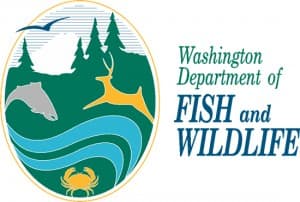Washington Wolf Recovery Still on Track, Wildlife Managers Tell Commission
OutdoorHub 10.08.12

Gray wolves are quickly re-establishing themselves in Washington state, despite the elimination of seven members of one pack that systematically preyed on a rancher’s cattle, state wildlife managers told the Washington Fish and Wildlife Commission at a public meeting last Friday (Oct. 5).
Speaking to a room packed with ranchers and wolf advocates, wildlife managers from the Washington Department of Fish and Wildlife (WDFW) outlined wolves’ recovery since 2007 and the department’s decision to remove the so-called Wedge pack in Stevens County late last month.
“No one wants to see a repeat of the situation that led to our action against the Wedge pack,” said Dave Ware, WDFW game manager. “But the fact remains that wolves are recovering more quickly than expected, and we have to anticipate there will be some conflicts along the way.”
WDFW Director Phil Anderson described how members of the Wedge pack – one of eight confirmed packs in the state – killed or injured 16 cows from the Diamond M ranch near the Canadian border from mid-July through late September. The department took lethal action only after a series of non-lethal measures employed by the rancher and state wildlife biologists failed to “break the cycle of predation,” he said.
“Killing wolves is definitely not our preferred option, but in this case we saw it as a last resort to address a bad situation,” Anderson said.
Many of the 41 members of the public who spoke at the meeting criticized WDFW’s use of lethal measures, while others said the department should do more to protect ranchers’ livestock.
For their part, members of the nine-member citizen commission that sets policy for WDFW credited Anderson and other state wildlife managers with keeping them – and the public – apprised of the situation.
“They kept us informed every step of the way,” said Commissioner Rolland Schmitten from Chelan County.
Since then, state and tribal biologists have confirmed the presence of another pack – the Strawberry pack – on the Colville Indian Reservation, said Donny Martorello, WDFW’s carnivore manager. The department is also working to confirm the presence of four other suspected packs in eastern Washington, he said.
Martorello said rapid in-migration of wolves from neighboring states and British Columbia is moving the state closer to reaching recovery goals established by the Wolf Conservation and Management Plan, adopted by the commission last December after five years of public review.
That plan establishes a goal of 15 breeding pairs of wolves distributed among three regions of the state for three years – or 18 pairs in one year – before the state can consider delisting gray wolves as an endangered species.
Martorello noted that Washington’s wolf management plan, like those in effect in all states with gray wolf populations, allows wildlife managers to use both lethal and non-lethal means to control wolf predation on cattle.
“Wolves are highly adaptable, prolific animals,” Martorello said. “Thousands of wolves have been killed to protect cattle in other states in recent decades, yet wolves continue to thrive.”
To minimize conflicts, Ware said WDFW will be working with ranchers to take additional steps to protect their cattle when they turn them out to pasture next year. Ranchers who enter into new cost-sharing agreements can qualify for assistance to pay for electric fencing, guard dogs, “range riders” and other protection measures.
“The success of wolf recovery in our state depends on social tolerance for these animals – especially among ranchers and others most affected by them,” Ware said.
In addition to wolf management, the commission considered several other issues at its Oct. 5-6 meeting in Olympia, including:
- Columbia River fisheries: The commission heard public comments on initial options developed by the Oregon Department of Fish and Wildlife and WDFW to restructure salmon and sturgeon fisheries on the lower Columbia River. Those proposals, developed at the request of Oregon Gov. John Kitzhaber, are posted on WDFW’s website at http://1.usa.gov/Q8EzHR . A workgroup consisting of three commissions from both Oregon and Washington will continue discussion of the proposals Oct. 18 in Portland. The Washington commission is schedule to take action on a final plan in December.
- Puget Sound shrimp policy review: The commission heard public comments on options proposed by WDFW to update the Puget Sound shrimp policy and potentially reallocate catch shares between commercial and recreational fishers. Those options are posted at http://1.usa.gov/OOyQKh . The commission is scheduled to make a final decision at its December meeting.
- Land acquisition: The commission approved a request by WDFW to purchase 80 acres of prime waterfowl habitat on Ephrata Lake in Grant County. A number of environmental groups and duck-hunting organizations have supported the acquisition.

